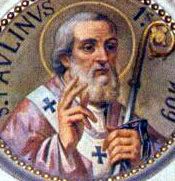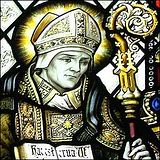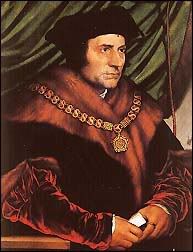June 22 - Sts. Paulinus, John Fisher & Thomas More
JUNE 22
The current Roman calendar lists three saints on June 22. Their stories are briefly presented here one after another.

ST. PAULINUS OF NOLA
St. Paulinus was born around 353 in Bordeaux, France. His father was a governor and a wealthy landowner. Paulinus received a good education. He became a lawyer and poet. He traveled in France, Spain and Italy, wherever work or pleasure took him. In 381, at the age of twenty-eight, he became the governor of Campania, Italy.
When he was thirty-six, Paulinus became a Catholic. He and his wife, Theresia, had one child, a son. After their son died, the couple gave away their wealth and property to the poor. They kept only what they needed to live on. Paulinus and Theresia agreed that they wanted to live simply. The couple prayed, made sacrifices and did without unnecessary things. They also chose to take a vow of chastity to witness to their love for Jesus. Paulinus and his wife were greatly admired by the Christian community. They were very pleased when Paulinus became a priest in 394. Then he and Theresia started a small community of monks in Nola, Italy. They opened a hospice for poor people and travelers, too.
Paulinus and Theresia decided to remain in Nola. Paulinus wanted to be near the shrine of one of his favorite saints, St. Felix of Nola. St. Felix had been a priest and bishop who had died in 260. He had been a defender of his people during the cruel persecution by Emperor Decius. Bishop Felix had been known for his prayerfulness, his love for the people, and his poor lifestyle. Over a century later, Paulinus prayed to him and wrote about him. He felt great confidence in the power of St. Felix. What could this former Roman governor have in common with St. Felix? More than St. Paulinus could have guessed. In 409, he was chosen to be bishop of Nola. The people were so happy. He was a wise, gentle bishop, just as St. Felix had been. He was praised by many great saints who lived at that time, St. Ambrose, St. Augustine, St. Jerome, St. Martin of Tours and others. Although some of his wonderful writings have been lost, thirty-two poems and fifty-one letters remain.
St. Paulinus was bishop of Nola until his death in 431.

ST. JOHN FISHER
John Fisher was born in Yorkshire, England, in 1469. He was educated at Cambridge University and became a priest. Father Fisher taught at Cambridge, too. He was a wonderful teacher and helped the students grow in their knowledge of the faith. He was a theologian. Father Fisher was especially helpful in pointing out religious errors of the times that confused some people.
In 1504, he became the bishop of Rochester, England. It was a poor diocese and Bishop Fisher was to remain its shepherd for thirty years. So, Bishop Fisher performed two important duties. He was a bishop of a diocese and the head of Cambridge University. In 1514, he was appointed the head of the university for life. Bishop Fisher was also the priest who heard the confessions of King Henry VIII's mother. Her name was Elizabeth of York.
Bishop Fisher had many friends, including the famous scholar, Erasmus, and the great St. Thomas More. Little did Bishop Fisher and Thomas More know that they would be sharing a feast day on the calendar of saints.
It certainly was not a celebration when Bishop Fisher was put in prison in 1533. He was arrested for insisting that the marriage of the king and Queen Catherine was true. Then Henry VIII divorced Catherine and married Anne Boleyn in a civil ceremony. He demanded that people sign an oath of loyalty to him. He made himself the head of the Church in England. Bishop Fisher would not sign the oath. He was sent to the Tower of London. The tower was damp and the treatment was harsh. Bishop Fisher suffered very much, but he would not betray his faith. Even though there were no televisions and radios, people found out about what Bishop Fisher, Sir Thomas More and the others were going through. They were shocked and saddened. On June 12, 1535, Pope Paul III named Bishop Fisher a cardinal. He hoped this would make Henry free him. But the king only became more angry and mean. He demanded Cardinal Fisher's death. John Fisher was killed on June 22, 1535.
Along with his friend, St. Thomas More, Cardinal John Fisher was proclaimed a saint by Pope Pius XI in 1935.

ST. THOMAS MORE
Thomas More was a famous lawyer and writer. He was born in London in 1477. His father had been a lawyer, too, and a judge. Thomas was always grateful to his father for being so loving and for not spoiling him.
Thomas' first wife, Jane Colt, died very young. More was left with four small children. He was married again, to a widow, a simple woman who could not even read or write. Her husband tried to teach her. Thomas made home life enjoyable for his family because he was so pleasant to be with. During meals, one of the children would read from the Bible. Then they would have fun and tell jokes. St. Thomas often asked poorer neighbors in to dinner, too. He always helped the poor as much as he could. He loved to delight his guests with surprises. He even kept some playful monkeys as pets. Yet few could have imagined how deeply spiritual St. Thomas really was. He prayed long hours into the night and performed penances, too. He was very much aware that being a true Christian took the grace and help of God.
Thomas held important government positions. For three years he was lord chancellor, another name for prime minister. Henry VIII used to put his arm affectionately around Thomas' shoulder. Yet although the saint was a most loyal subject, he was loyal to God first of all. In fact, when the king tried to make him disobey God's law, Thomas refused. Henry wanted to obtain a divorce from his wife to marry another woman. However, the pope could not give permission, since that is against God's law. Henry was stubborn and at last he left the Church. He wanted everyone to recognize him as the head of the Church in England. Thomas could not do that. He chose to remain faithful to the Catholic faith and to God. He was condemned to death for that, yet he forgave his judges. He even said he hoped he would see them in heaven. He really meant it, too.
At the scaffold, where he was to die, St. Thomas kissed his executioner on the cheek. Then he joked, saying that his beard should not be cut off because it had not done anything wrong. He was martyred on Tuesday, July 6, 1535, at the age of fifty-seven.
Along with his friend, Bishop John Fisher, Sir Thomas More was proclaimed a saint by Pope Pius XI in 1935.


0 Comments:
Post a Comment
<< Home